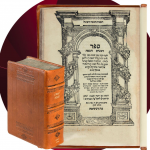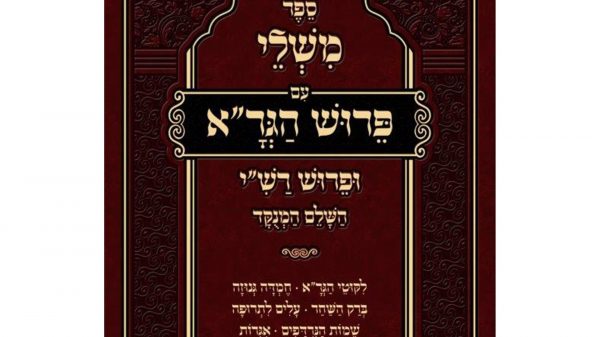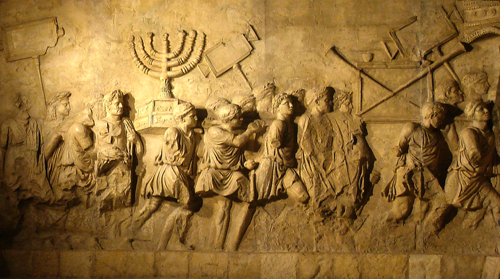Click here to download PDF
Faulty Weights & Amalek
In this week’s Parsha, we have the obligation to maintain only accurate weights and measures and the prohibition to produce or to have inaccurate weights and measures even if they will not be used for commerce (25:13-16). Immediately following these Mitzvos regarding weights and measures, we have the Mitzvah to remember what Amalek did to us, the Mitzvah to obliterate him and the prohibition against forgetting how we must hate Amalek forever and dispose of him. Rashi (25:17) says that the two sets of Mitzvos are next to each other to teach you that “if you are dishonest in weights and measures, Hashem makes you vulnerable to attack from an /enemy (like Amalek)”. Why should this be the case? We find in Parshas Beshalach that Amalek came because the Jewish people asked (Shemos 17:7) “HaYesh Hashem b’kirbeinu” – Is Hashem in our midst Im Ayin – or not”, which Rashi (Shemos 17:8) explains to mean that after all Hashem did for them the Jews were questioning how Hashem is truly taking care of them, and therefore Hashem allowed Amalek to attack so the Jews would be forced to cry out to Hashem and acknowledge Him. What does this have to do with being dishonest about weights and measures?
Like “Chometz” and worse
The prohibition of maintaining inaccurate weights and measures is far-reaching and goes way beyond being dishonest in commerce. We are not even permitted to create such weights, even if they will not be used, and we must dispose of them even if they’ve been decommissioned to be used for non-commercial purposes, even if just used the restroom (Bava Basra 59B). In Parshas Kedoshim (Vayikra 20:35) the Pasuk says: “Do not do injustice in judgment, in measures, weights and volumes (of liquids)” Rashi there says that from here Chazal learned that to make an inaccurate measurement is like a judge miscarrying justice. Indeed, the Rambam in the Sefer HaMitzvos lumps together the prohibition of inaccurate weights and measures with the prohibition to miscarry justice (Lo Ta’aseh 271-273) In the opinion of the sefer HaChinuch even a discrepancy in the measures that would only cause a deviation of less than the value of a ‘perutah’ is Biblically prohibited. What is so evil about lying about weights and measures to the point that Chazal say, “the punishment that Hashem delivers to those who lie in weights and measures is more severe than [the punishment of] someone guilty of promiscuity” (Bava Basra 88 B)?
What irked the Jews?
In Parshas Beshalah, when the Jews got frustrated by not having water, it says, “Nasotam” – they tested Hashem by saying “HaYesh” – is Hashem in our midst or ”Ayin” – which literally nothing or nowhere. These terms ring familiar as we believe Hashem created the world “Yesh m’Ayin” – something out of nothing or nowhere. A Pasuk that amazingly crosses over between how we use these terms to describe creation and how the Jewish people use these terms in describing their frustration as to how Hashem helps them, is in the Pasuk in Tehillim, “I lift up my eyes to the mountains, m’Ayin – from where will come my help? My help comes from Hashem who makes Heaven and earth”. There is a clearly a connection between how these terms are used, but what is it?
Two-Tiered War
The first war against Amalek is categorically different from any other war the Jewish people faced in their history. We had the conventional warfare by the sword led by Yehoshua and we had Moshe Rabbeinu on the mountain top with his hands raised in prayer. When his hands were raised, the Jewish people were victorious and when his hands lowered, the Jewish people would lose their advantage at those moments. Why did the war against Amalek require Moshe with his hands up and in what way is it a ‘midda knegged midda’ to their having raised the issue of ‘Yesh’ or ‘Ayin’?
Meanings of Midda
A general term for measurement is “midda”. This term also means character trait and it also means principle, as in the 13 “middos” that the Torah is interpreted with. What is the common denominator between these diverse applications of this term? To ‘define’ is to lay down a measurement. When defining something you are ruling out infinite possibilities and limiting it to a distinct quantity of properties. When defining those properties, you are measuring them whether they are mass, or the effects that they have on our senses or other entities. In a laboratory where something is being examined, it is subjected to measurements and based on the measurements, a definition or diagnosis is arrived at.
Character Traits & Principles
A character trait is a definite measure of character. Kindness has its measured definitions that are exclusive of anything cruel, callous or uncaring. To be mighty has its definite measured parameters that exclude any cowardice or weakness. Principles have their definitions. A “Kal ve’chomer” has its definite parameters as to what makes it legitimate and what may be derived from it. When passing the information of Torah through the measure of “Kal ve’chomer”, only certain ideas can come from such as measure. “Klal u’Prat u’Klal” – is a measure. Only certain information can fit into that measure – it must measure of two generalizations and some details in the middle. Only certain results will emerge after having applied that measure. Principles that we use to interpret the Torah or to guide us are intellectual and moral yardsticks and that’s why they are called “middos” – measures.
Warped Mind
With this we can understand how inaccurate weights and measures are living metaphors for unmitigated evil. Its not just about cheating someone else. It’s about having warped ideas and having your internal moral scale out of balance. That is why the Torah drops a hint that Chazal found that to have faulty weights and measures is the equivalent of miscarriage of justice. Faulty weights and measures represent working with pseudo-values that are not in accordance with real Torah values and being imbalanced in the way you weigh out a situation, contrary to pure “Daas Torah”. With this we can understand why the punishment for being dishonest in weights and measures is greater than the punishment for promiscuity. It goes way beyond the conventional explanation that when you used inaccurate weights for any length of time, you may lose track of who you cheated and can not restore their losses. It’s much worse than that. A person who succumbed to promiscuity knows that he was wrong and failed. Having inaccurate weights and measures represents being warped and having a corrupted value system and moral compass. Such a person would not even know that he is wrong and needs to change and make amends.
Yesh & Ayin
The Jewish people worded their question-styled statement as ‘HaYesh’ is Hashem in our midst – ‘im Ayin’ – or nowhere. They did not question the existence of Hashem. What were they really asking? What do the terms ‘Yesh’ and ‘Ayin’ really mean? ‘Yesh’ means ‘there is’ or ‘to have’ which applies to something tangible. ‘Ayin’ doesn’t only mean ‘nothingness’. It refers to anything that is imperceivable. ‘Nothingness’ is imperceivable, but anything imperceivable can also be called ‘Ayin’. In the Pasuk in Tehillim quoted above, ‘m’Ayin’ – from where will come my help – Dovid HaMelech is saying: “I don’t see a way out….I don’t see a solution”. He reassures himself that “my help comes from Hashem who makes Heaven and earth” – if Hashem can make a universe out of nothing and nowhere, He can certainly provide a solution to my problem. That is called “from “Ayin” from out of nowhere will come my help – just like Heaven and Earth came out of nowhere. When Hashem conducts our affairs above our ability to understand and measure that mode of conduct is called ‘Ayin’, as we can’t see where our sustenance and protection is coming from. ‘Yesh Hashem b’kirbeinu’ – Hashem is in our midst means that we can measure how Hashem is helping us and assisting us in our efforts.
Perceived Conflict
The Jewish people were frustrated. They saw miracle after miracle, but all these miracles were “coming out of nowhere”. In no way (Ayin) could they scientifically explain their survival and expect it to continue. Perhaps they could have just “leaned back and enjoyed the ride”, if not for the fact that there was a lull in between the miracles when they felt need and were wondering whether they have to make more “Hishtadlus” -efforts of their own, or not. Therefore, they formulated a statement of frustration in the form of a question, but it was a statement, a test: “HaYesh” – is Hashem in our midst where the mode of conduct will be one that we can understand and participate in, or will it be “Ayin” – out of nowhere, where we just have to have “Bitachon”-faith that Hashem will provide our needs without us playing a role at all. Hence their test of ‘Yesh’ or ‘Ayin’?
Ask – Don’t Test
The Zohar, after defining these terms as we did (albeit using Kabbalistic jargon) says that if this would have been a” sh’eila”- a honest enquiry, it would not be any sin on their part. But it wasn’t a question – It was a test – “which is it” – as if the one precludes the other. A person’s “weights and measures” i.e. terms, values and ideas that he works with must be accurate and his internal scale must be perfectly balanced to correctly weigh out, compare and contrast those terms. In the case of the Jewish people, they were working with the accurate terms of ‘Yesh’ and ‘Ayin’ but their inner scale of measuring these terms as mutually exclusive was corrupt. This is the famous perceived tension between “Histhtadlus” which becomes active in the framework of “Yesh” and “Bitachon” which is what needs to be employed in situations of “Ayin”. But there is no contradiction, it’s a sliding scale. Some situations demand more “Bitachon” and less “Histhtadlus” and some situations demand additional “Hishtadlus” also. It’s a slope, rather than two opposites like the very term “Yesh m’Ayin”. Their sin was ‘al nasosam’ –testing, prejudging that it must be either one or the other.
Merging Heavy Hishtadlus with Absolute Bitachon
The Tikun for the Jewish people deciding on their own, the falsity that there is a wedge between ‘Yesh’ and ‘Ayin’ was to be put in a situation where they had to work with both terms actively, simultaneously. Under the leadership of Yehoshua, they had to choose men which includes all strategic planning and make the maximum “Hishtadlus” to try to attain victory by the sword in hand, which is ‘Yesh’. At the same time, they had to observe Moshe with the hands totally surrendered to Hashem in prayer with the recognition that all our “Hishtadlus” is really nothing and subjugate themselves totally to the absoluteness of Hashem, which is ‘Ayin’. Only with the two together were they victorious.
Amalek’s Foothold
As is well known, Amalek is the nation that brings doubt and confusion to the world. He attacked the Jewish people merely for the sin of them thinking that they know how to weigh out the ‘Yesh’ and the ‘Ayin’. How much more so if the basic terms and ideas are false to begin with. This is what Rashi means to say in our Parsha. “If you lie about weights and measures” which is to blur the terms and to be blurry in judgment, that is what empowers Amalek and Amalek will be granted room to increase that blur and confusion.
Elul & Two Hearts
The Baal HaTurim brings an allusion to Elul from the Pasuk, ‘and Hashem will correct es levavcha v’es levav’ your heart and the heart of [your descendants]’. The first letters of “your heart and the heart of” spells out Elul. The obvious question is: what are the two hearts, especially as we don’t finish off with the word of ‘zarachah’ your descendants? I propose that the Baal HaTurim meant as follows: The heart is Both the seat of our core values and it also understands and extrapolates and makes judgments. The Rambam in the Moreh Nevuchim, (section 1, chapter 7) explains that our basic elemental notions are like parents. The new ideas that we construct based on those axioms are like children. With this Rambam we could appreciate what Chazal mean when they say that there are “Avos”- parents i.e. precedents and “Toldos” – children i.e. derivations in Shabbos and Nezikin. As we have mentioned in the past (see Even Shesiya Re’eh, 5779) during Elul we are working on building our heart, turning a heart of stone into Luchos Habris. The heart must be instilled with both accurately defined Torah values and it also must be conditioned to think straight in line with these Torah values to produce Torah true chiddushei Torah. With this we can understand why as much as Torah shebaal peh has been written and even translated, you still must have a Rebbe. We need a Rebbe who has a Mesorah from his Rebbe as to what the terms really mean as there may not be an adequate term in English or whatever our spoken language, to capture what that Torah term really means. Even more fundamentally, you need a Rebbe for “a derech in learning” to teach you the Torah way of how to weigh out, compare and contrast the ideas to handle the ideas in line with Daas Torah, to come up with Chiddushim that are l’amita shel Torah. The Baal HaTurim was saying to correct “your heart” is to instill it with solid Torah true axioms “and the heart of” is your second heart, that is descendent oriented, the function of the heart that weighs out the axioms to produce new ideas for the new questions that arise in every generation. Both functions of the heart should always be in accordance with the truth of the Torah.








